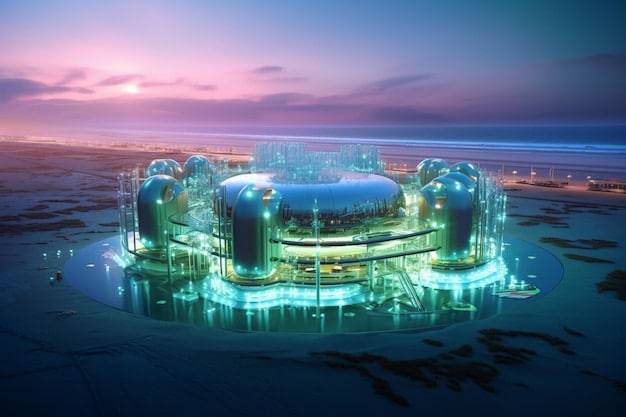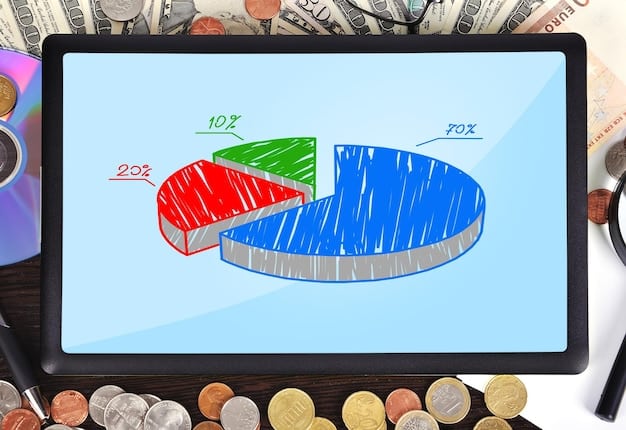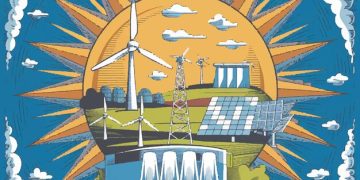Latest US Incentives for Green Hydrogen Production in 2025

In 2025, the US government offers significant incentives, including tax credits and grants, to encourage investment in green hydrogen production, aiming to reduce carbon emissions and promote sustainable energy sources.
Are you looking to invest in green hydrogen production in 2025? The **latest US government incentives for investing in green hydrogen production in 2025** are designed to boost the industry and help achieve climate goals. Here’s what you need to know.
Understanding Green Hydrogen and Its Importance
Green hydrogen is produced through the electrolysis of water, powered by renewable energy sources. This makes it a clean energy carrier with the potential to decarbonize various sectors. It’s crucial for achieving net-zero emissions.
What is Green Hydrogen?
Green hydrogen is hydrogen produced from renewable energy sources, such as solar, wind, and hydroelectric power. Unlike grey or blue hydrogen, which rely on fossil fuels, green hydrogen offers a sustainable and environmentally friendly alternative.
Why Green Hydrogen Matters?
Green hydrogen can play a significant role in reducing carbon emissions in sectors like transportation, industry, and power generation. It can also be used for energy storage, providing a buffer for intermittent renewable energy sources.

- Decarbonization: Reduces carbon emissions in hard-to-abate sectors.
- Energy Storage: Provides long-term energy storage solutions.
- Fuel Versatility: Can be used in fuel cells, industrial processes, and more.
As countries worldwide ramp up their efforts to combat climate change, green hydrogen is emerging as a key component of a sustainable energy future. Incentives and policies promoting its production and use are gaining traction.
Key Incentives Under the Inflation Reduction Act
The Inflation Reduction Act (IRA) is a landmark piece of legislation that offers significant incentives for green hydrogen production. These incentives aim to make green hydrogen economically competitive and accelerate its deployment.
Production Tax Credit (PTC)
The PTC offers a tax credit for each kilogram of green hydrogen produced. The amount varies based on the carbon intensity of the production process, with higher credits for lower emissions.
Investment Tax Credit (ITC)
The ITC provides a tax credit for investments in green hydrogen production facilities. This can significantly reduce the upfront capital costs associated with building new projects.
- PTC: Tax credit per kilogram of green hydrogen produced.
- ITC: Tax credit for investments in production facilities.
- Eligibility: Based on carbon intensity and project type.
These incentives are designed to encourage both the production and deployment of green hydrogen, making it a more attractive option for investors and businesses.
Specific Details of the 45V Tax Credit
The 45V tax credit is a specific provision within the Inflation Reduction Act that focuses on clean hydrogen production. Understanding the details of this credit is crucial for those looking to invest in green hydrogen.
Calculating the 45V Credit
The 45V credit is calculated based on the lifecycle greenhouse gas emissions rate of the hydrogen production process. The lower the emissions, the higher the credit.
Requirements for Claiming the Credit
To claim the 45V credit, projects must meet certain requirements, including registering with the IRS and providing documentation of their lifecycle emissions. Regulations are still being finalized.

- Emissions Rate: Credit based on lifecycle greenhouse gas emissions.
- Registration: Projects must register with the IRS.
- Documentation: Provide documentation of emissions.
Navigating the details of the 45V tax credit can be complex, but it offers a substantial financial incentive for those committed to producing green hydrogen. Seeking expert advice is recommended.
Other Federal Grant Programs
In addition to tax credits, the US government offers various grant programs to support green hydrogen production. These programs provide funding for research, development, and deployment of hydrogen technologies.
Department of Energy (DOE) Programs
The DOE has several programs aimed at advancing hydrogen technologies, including funding opportunities for electrolyzer development, hydrogen storage, and infrastructure projects.
Regional Clean Hydrogen Hubs
The DOE is also establishing regional clean hydrogen hubs across the country. These hubs will bring together producers, consumers, and infrastructure to create a hydrogen ecosystem. Each hub is expected to focus on different end-use applications.
The Bipartisan Infrastructure Law authorized $8 billion for the establishment of these regional hubs. The goal is to demonstrate the production, processing, delivery, storage, and end-use of clean hydrogen across various sectors.
These programs and hubs are critical for fostering innovation and scaling up green hydrogen production. They provide a platform for collaboration and knowledge sharing.
State-Level Incentives for Green Hydrogen
Many states are also offering their own incentives to encourage green hydrogen production. These state-level incentives can complement federal programs and further enhance the economic viability of projects.
California’s Initiatives
California has a strong commitment to green hydrogen and offers various incentives, including tax credits, grants, and regulatory support. The state is aiming to become a leader in hydrogen technology.
New York’s Approach
New York is also actively supporting green hydrogen through investments in research, infrastructure, and pilot projects. The state is focusing on using hydrogen to decarbonize its power sector and transportation system.
- California: Tax credits, grants, and regulatory support.
- New York: Investments in research and infrastructure.
- Other States: Developing their own incentive programs.
Exploring state-level incentives can provide additional financial benefits for green hydrogen projects. It’s important to stay informed about the specific programs available in your state.
Future Outlook: Green Hydrogen in 2025 and Beyond
The future of green hydrogen looks promising, with increasing government support, technological advancements, and growing demand. By 2025, green hydrogen is expected to play an increasingly important role in the energy transition.
Technological Advancements
Ongoing research and development efforts are focused on improving the efficiency and reducing the cost of electrolyzers. Advances in materials science and manufacturing processes are driving down the cost of green hydrogen production.
Market Growth
The market for green hydrogen is expected to grow significantly in the coming years, driven by demand from various sectors, including transportation, industry, and power generation. Supportive policies and incentives will further accelerate this growth.
- Technological Advancements: Improving electrolyzer efficiency and reducing costs.
- Market Growth: Increasing demand from various sectors.
- Policy Support: Supportive policies and incentives driving growth.
Investing in green hydrogen now can position you to capitalize on this growing market and contribute to a sustainable energy future. The combination of government incentives and technological progress makes it an attractive opportunity.
| Key Point | Brief Description |
|---|---|
| 💰 Inflation Reduction Act | Offers significant tax credits (PTC & ITC) for green hydrogen production. |
| 🏭 45V Tax Credit | Specific tax credit based on the lifecycle greenhouse gas emissions rate. |
| grants | Funds research, development, and deployment of hydrogen technologies. |
| hubs | Establishes regional ecosystems to bolster green hydrogen production & use. |
Frequently Asked Questions
▼
Green hydrogen is hydrogen produced from renewable energy sources, such as solar, wind, and hydroelectric power. This method ensures that the production process is carbon-neutral.
▼
The Inflation Reduction Act offers significant tax credits, including the Production Tax Credit (PTC) and the Investment Tax Credit (ITC), to make green hydrogen economically competitive.
▼
The 45V tax credit is a specific provision within the Inflation Reduction Act that provides a tax credit based on the lifecycle greenhouse gas emissions rate of hydrogen production.
▼
Yes, many states, including California and New York, offer their own incentives, such as tax credits and grants, to further support green hydrogen production within their borders.
▼
The future looks promising, with ongoing technological advancements, market growth, and supportive policies expected to drive the increasing adoption and importance of green hydrogen in the energy transition.
Conclusion
Investing in green hydrogen production in 2025 presents a significant opportunity, driven by favorable government incentives and growing market demand. By understanding and leveraging these incentives, businesses and investors can play a key role in building a sustainable energy future.





